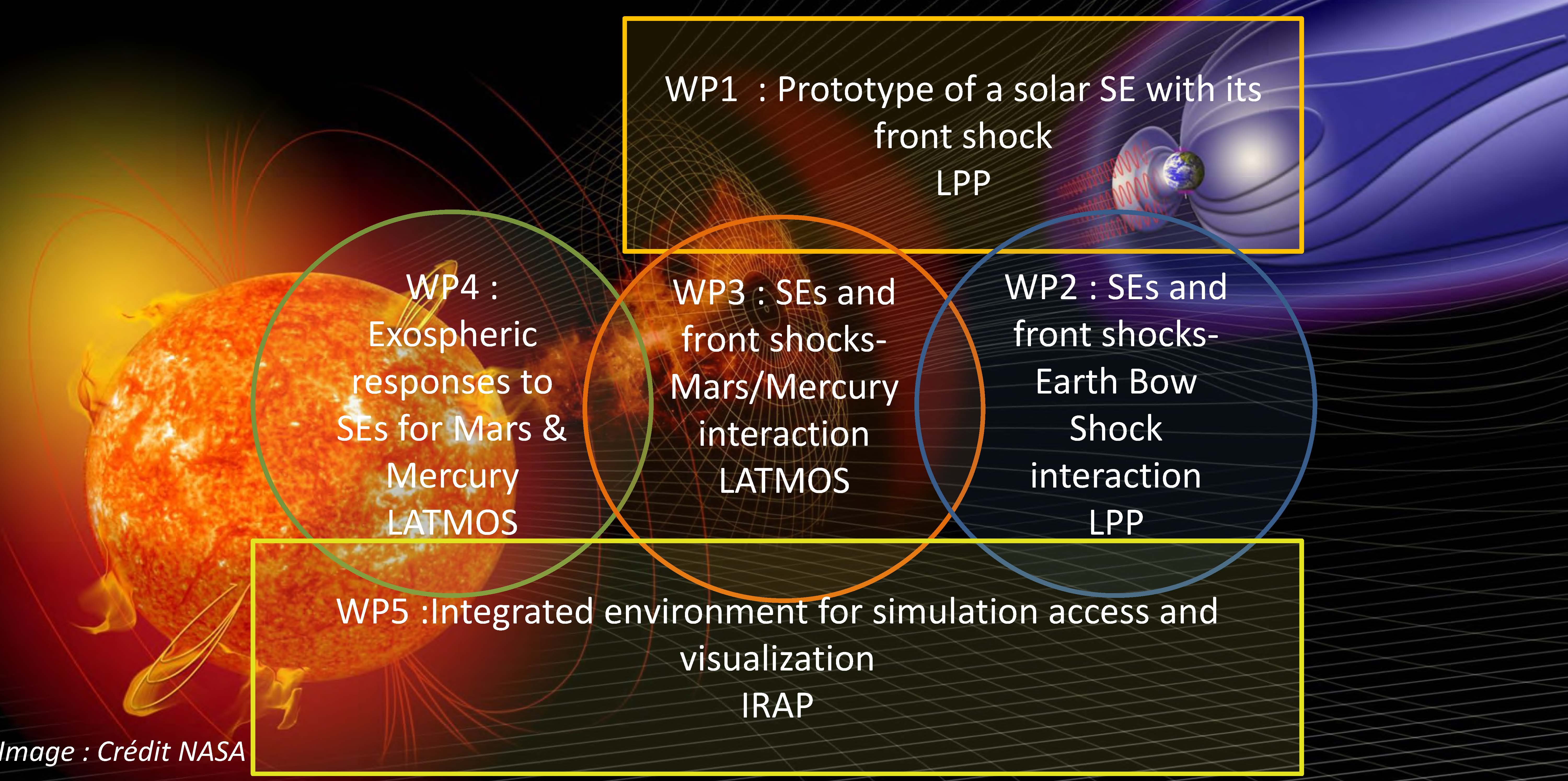In this project, we plan to use and extend simulation models to describe the complete interaction of SE (including its
different phases: interplanetary shock, sheath, ejecta,…) with Earth’s BS and magnetosheath and apply them to weakly magnetized objects
like Mars and Mercury, in order to predict for the first time the
consequences of such encounter on the magnetic and atmospheric/exospheric
environments of these objects. Our main scientific goals are:
a- Characterizations of the magnetosphere’s responses to Solar Events.
- How does a magnetosphere react when an interplanetary shock, formed
upstream of an ICME, encounters a magnetosphere (induced or intrinsic)? How the
planetary BS and magnetopause are impacted?
- What are the respective responses of the magnetosphere to the central
part of the SE and to their leading edge (shock + sheath)?
b- Impacts of Solar Events on the upper atmosphere/exosphere (Mars and
Mercury) and their implication on the neutral atmosphere and surface.
- What are the consequences
for the upper atmosphere/ exosphere? Can we identify signatures of such
encounter in the exosphere?
- Are transient events more
important in terms of escape than steady state interaction?
c- Determination of the reconfiguration time scales.
- Are reconfiguration time scales proportional to the effective size of
the obstacle?
- What are the typical timescales for the upper atmosphere/exosphere
after a magnetic configuration change?
Joint simulation and data
analysis investigations will address these questions.
Simulations results will be compared to
observations through the CDPP visualization tools to first validate the numerical developments and address
the scientific questions of the project.
Two main numerical and technical challenges are identified in the frame of this proposal:
a- Modelling
an interplanetary shock interaction with a planetary BS. Global investigations of transient events on Mars and
Mercury on ion scales are very limited and never been addressed with a kinetic
model. This project aims to go further and to perform a systematic study of time-dependent drivers (change of density,
speed, interplanetary magnetic field direction and magnitude) and their impact on the magnetospheres and
exospheres. We aim to simulate the interaction of an Interplanetary Shock
with a planetary magnetosphere. Similarly, the exospheric model can be run
under varying upstream conditions.
b- Visualization of large simulated data products and comparison with observations.
When investigating transient events, we will have to construct series of
snapshots. To track a temporal variation,
about 30 to 50 snapshots will be needed to follow the responses of the
magnetosphere and exosphere which will represent a large amount of memory. We
will analyse these runs using a standardized protocol of exchange of
information (1D to 4D data) between visualization tools and simulation database
which requires extending existing
protocols to time-dependent simulations.
The four-year project is divided in 5 work-packages (WP) closely linked together as presented in
figure 3. We first propose to self-consistently
simulate a prototype of “realistic” solar events (hereafter SE) in the
pristine solar wind, including both its central core and the shock wave
preceding it, and to push it and collide with the pre-existing planetary bow
shock and environment (WP1). This
prototype solar event will be used in the following WP2 to analyze its
interaction with the boundaries of terrestrial environment.
|
 Organization of the
Work-Packages Organization of the
Work-Packages
|
WP1 results will similarly
be used to describe the SE interaction with Mars/Mercury in WP3.
Intermediate steps are considered to evaluate the effect of different SW
drivers on the magnetosphere. These simulations will be coupled (both
ways) to the exospheric model in WP4 to characterize the atmospheric
responses.
IT developments in WP5 will support observation /
simulation comparisons.
|
 Organization of the
Work-Packages
Organization of the
Work-Packages